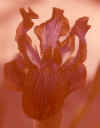I. stolonifera
|
Accorded species status on the basis of the 1880 description of Russian botanist Karl Johann Maximowicz. Generally considered less attractive than I. korolkowii, it has nevertheless been a favorite of hybridizers because its tetraploid nature can serve as a bridge between the diploid arils and tetraploid TBs. Many variants have been identified. Some have been registered, but others merely shared by hybridizers. Click on the thumbnails to see larger versions of these pictures. |
|
| I. stolonifera conical. Listed by Rainbow Gardens in 1951, described as having the markings of I. stolonifera but a conical form. |
Photo Not Available |
| DECORATED BLUE BEARD. A selected clone registered by Lloyd Austin in 1956 and introduced in 1957. A pinkish rust self, margined russet-brown, with a bright blue beard. |
Photo Not Available |
| DECORATED DELIGHT. A selected clone registered by Lloyd Austin in 1956 and introduced in 1957. White ground, marked with brown and rosy-lavender. |
Photo Not Available |
| DECORATED GIANT. A selected clone registered and introduced by Lloyd Austin in 1955. White ground, bordered in chocolate & mahogany, veined in dark crimson. marked with brown and rosy-lavender. |
Photo Not Available |
| 'George Barr' Not registered, but listed by Potterton & Martin in 1993. "Standards white shaded heliotrope-violet, broadly edged dark chocolate brown. Lilac falls, narrow chocolate-brown edge, sky-blue beard. White towards center of flower, chocolate veined." |
Photo Not Available |
| HERE I AM. An advanced-generation clone from (Red White and Blue X Decorated Giant), registered by Elm Jensen in 1985. A late-blooming, lilac-blue self with an amethyst blush on the falls. It probably survives, but imposters are also now in distribution. |
Photo Not Available |
| I. stolonifera LEICHTLINI. When offered by Rainbow Gardens, this was described as more brown and more ruffled than the typical clone. At one time, I. leichtlini was accorded species status, later deemed to be a synonym of I. stolonifera. | |
| MERLIN'S MAGIC. An advanced-generation clone from (Turkish Dancer X Here I Am), registered by Elm Jensen in 1985. This picture does match the registered description, suggesting that in I. stolonifera the veining pattern is dominant over the solid pattern. |
 |
| PERSIAN CUPID. Purportedly an Austin selection, passed around among hybridizers for many years, but neither registered nor introduced. |
 |
| REAL HARMONY. A selected clone registered and introduced by Lloyd Austin in 1956. Soft-amethyst-ground standards bordered russet, velvety bronze-crimson falls blended to tawny-brown edges. |
Photo Not Available |
| RED WHITE AND BLUE. A selected clone registered by Lloyd Austin in 1956 and introduced in 1957. Standards white and chocolate brown, falls dark red with lighter border and a dark blue beard. |
Photo Not Available |
| TURKISH DANCER. A clone reportedly selected by Lloyd Austin, registered by the Aril Society in 1983. Pale lilac ground, marked violet and brown, with a blue beard. |
Photo Not Available |
| TURKISH DELIGHT. A Lloyd Austin selection, introduced by the Court of Iris in 1962 and registered by Bill Hawkinson in 1976. S. soft greyed-amber with pale blue flush, lightly veined in amber; F. brighter with a blue flush and blue beard. |
Photo Not Available |
| VAGA. Described by Sir Michael Foster before 1900, but ultimately determined to be a synonym of I. stolonifera. |
Photo Not Available |
| VERA. A Van Tubergen creation, not registered and of unknown pedigree, but described as a "brown, stolonifera-type". |
 |
| ZWANENBURG BEAUTY. A Van Tubergen creation, not registered and of unknown pedigree, but widely believed to be an advanced-generation hybrid of I. stolonifera. |
Photo Not Available |
|
Many reference books provide additional information concerning this species. See the Reference Lists, or return to Regelia Species. |
|
History | Hybridizing | Library | List of Cultivars | Photo Gallery
